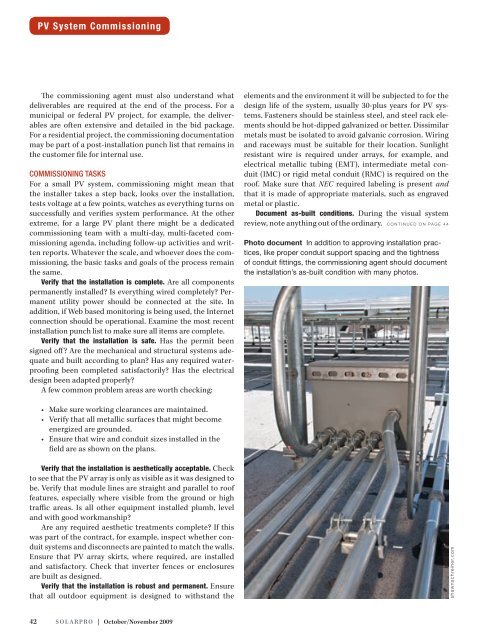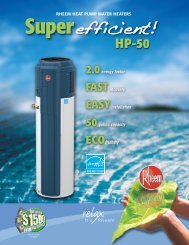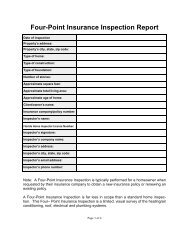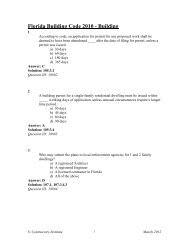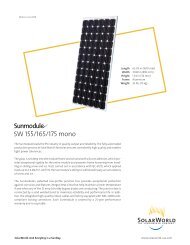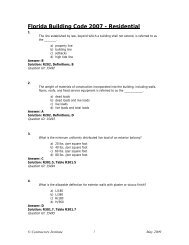SolarPro Magazine.pdf - Contractors Institute
SolarPro Magazine.pdf - Contractors Institute
SolarPro Magazine.pdf - Contractors Institute
- No tags were found...
You also want an ePaper? Increase the reach of your titles
YUMPU automatically turns print PDFs into web optimized ePapers that Google loves.
PV System CommissioningThe commissioning agent must also understand whatdeliverables are required at the end of the process. For amunicipal or federal PV project, for example, the deliverablesare often extensive and detailed in the bid package.For a residential project, the commissioning documentationmay be part of a post-installation punch list that remains inthe customer file for internal use.Commissioning TasksFor a small PV system, commissioning might mean thatthe installer takes a step back, looks over the installation,tests voltage at a few points, watches as everything turns onsuccessfully and verifies system performance. At the otherextreme, for a large PV plant there might be a dedicatedcommissioning team with a multi-day, multi-faceted commissioningagenda, including follow-up activities and writtenreports. Whatever the scale, and whoever does the commissioning,the basic tasks and goals of the process remainthe same.Verify that the installation is complete. Are all componentspermanently installed? Is everything wired completely? Permanentutility power should be connected at the site. Inaddition, if Web based monitoring is being used, the Internetconnection should be operational. Examine the most recentinstallation punch list to make sure all items are complete.Verify that the installation is safe. Has the permit beensigned off ? Are the mechanical and structural systems adequateand built according to plan? Has any required waterproofingbeen completed satisfactorily? Has the electricaldesign been adapted properly?A few common problem areas are worth checking:elements and the environment it will be subjected to for thedesign life of the system, usually 30-plus years for PV systems.Fasteners should be stainless steel, and steel rack elementsshould be hot-dipped galvanized or better. Dissimilarmetals must be isolated to avoid galvanic corrosion. Wiringand raceways must be suitable for their location. Sunlightresistant wire is required under arrays, for example, andelectrical metallic tubing (EMT), intermediate metal conduit(IMC) or rigid metal conduit (RMC) is required on theroof. Make sure that NEC required labeling is present andthat it is made of appropriate materials, such as engravedmetal or plastic.Document as-built conditions. During the visual systemreview, note anything out of the ordinary. continued on page 44Photo document In addition to approving installation practices,like proper conduit support spacing and the tightnessof conduit fittings, the commissioning agent should documentthe installation’s as-built condition with many photos.• Make sure working clearances are maintained.• Verify that all metallic surfaces that might becomeenergized are grounded.• Ensure that wire and conduit sizes installed in thefield are as shown on the plans.Verify that the installation is aesthetically acceptable. Checkto see that the PV array is only as visible as it was designed tobe. Verify that module lines are straight and parallel to rooffeatures, especially where visible from the ground or hightraffic areas. Is all other equipment installed plumb, leveland with good workmanship?Are any required aesthetic treatments complete? If thiswas part of the contract, for example, inspect whether conduitsystems and disconnects are painted to match the walls.Ensure that PV array skirts, where required, are installedand satisfactory. Check that inverter fences or enclosuresare built as designed.Verify that the installation is robust and permanent. Ensurethat all outdoor equipment is designed to withstand theshawnschreiner.com42 <strong>SolarPro</strong> | October/November 2009


